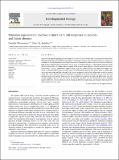| dc.contributor.author | Wenemoser, Danielle | |
| dc.contributor.author | Reddien, Peter | |
| dc.date.accessioned | 2015-03-17T20:31:45Z | |
| dc.date.available | 2015-03-17T20:31:45Z | |
| dc.date.issued | 2010-06 | |
| dc.date.submitted | 2010-05 | |
| dc.identifier.issn | 00121606 | |
| dc.identifier.issn | 1095-564X | |
| dc.identifier.uri | http://hdl.handle.net/1721.1/96061 | |
| dc.description.abstract | Regeneration requires signaling from a wound site for detection of the wound and a mechanism that determines the nature of the injury to specify the appropriate regenerative response. Wound signals and tissue responses to wounds that elicit regeneration remain poorly understood. Planarians are able to regenerate from essentially any type of injury and present a novel system for the study of wound responses in regeneration initiation. Newly developed molecular and cellular tools now enable study of regeneration initiation using the planarian Schmidtea mediterranea. Planarian regeneration requires adult stem cells called neoblasts and amputation triggers two peaks in neoblast mitoses early in regeneration. We demonstrate that the first mitotic peak is a body-wide response to any injury and that a second, local, neoblast response is induced only when injury results in missing tissue. This second response was characterized by recruitment of neoblasts to wounds, even in areas that lack neoblasts in the intact animal. Subsequently, these neoblasts were induced to divide and differentiate near the wound, leading to formation of new tissue. We conclude that there exist two functionally distinct signaling phases of the stem cell wound response that distinguish between simple injury and situations that require the regeneration of missing tissue. | en_US |
| dc.description.sponsorship | National Institutes of Health (U.S.) (R01GM080639) | en_US |
| dc.description.sponsorship | American Cancer Society (RSG-07-180-01-DDC) | en_US |
| dc.description.sponsorship | W. M. Keck Foundation | en_US |
| dc.description.sponsorship | Thomas D. and Virginia W. Cabot (Career Development Professorship) | en_US |
| dc.description.sponsorship | Searle Scholars Program | en_US |
| dc.description.sponsorship | Smith Foundation | en_US |
| dc.description.sponsorship | Rita Allen Foundation | en_US |
| dc.language.iso | en_US | |
| dc.publisher | Elsevier | en_US |
| dc.relation.isversionof | http://dx.doi.org/10.1016/j.ydbio.2010.06.017 | en_US |
| dc.rights | Article is made available in accordance with the publisher's policy and may be subject to US copyright law. Please refer to the publisher's site for terms of use. | en_US |
| dc.source | Elsevier | en_US |
| dc.title | Planarian regeneration involves distinct stem cell responses to wounds and tissue absence | en_US |
| dc.type | Article | en_US |
| dc.identifier.citation | Wenemoser, Danielle, and Peter W. Reddien. “Planarian Regeneration Involves Distinct Stem Cell Responses to Wounds and Tissue Absence.” Developmental Biology 344, no. 2 (August 2010): 979–991. © 2010 Elsevier Inc. | en_US |
| dc.contributor.department | Massachusetts Institute of Technology. Department of Biology | en_US |
| dc.contributor.department | Whitehead Institute for Biomedical Research | en_US |
| dc.contributor.mitauthor | Reddien, Peter | en_US |
| dc.contributor.mitauthor | Wenemoser, Danielle | en_US |
| dc.relation.journal | Developmental Biology | en_US |
| dc.eprint.version | Final published version | en_US |
| dc.type.uri | http://purl.org/eprint/type/JournalArticle | en_US |
| eprint.status | http://purl.org/eprint/status/PeerReviewed | en_US |
| dspace.orderedauthors | Wenemoser, Danielle; Reddien, Peter W. | en_US |
| dc.identifier.orcid | https://orcid.org/0000-0002-5569-333X | |
| mit.license | PUBLISHER_POLICY | en_US |
| mit.metadata.status | Complete | |
